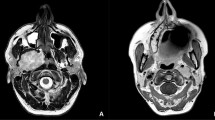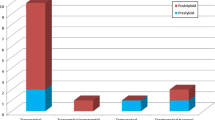Abstract
To analyze the feasibility, surgical outcomes and possible risks and complications encountered during transoral robotic surgery (TORS) for approaching parapharyngeal space (PPS) tumours, a retrospective cohort study was conducted. Out of 108 TORS procedures performed, 5 PPS tumours were identified from May 2011- November 2017. This study included 2 retrostyloid (benign nerve sheath tumour) and 3 prestyloid tumours (pleomorphic adenoma), of which one patient had previously undergone a transcervical approach for deep lobe of parotid pleomorphic adenoma. Average tumour dimensions were 4.56 × 4.5 × 3.64 cm, with largest antero-posterior, medial—lateral and craniocaudal dimensions being, 5.1 cm, 7.1 cm and 6.5 cm, respectively. Adverse peri-operative events encountered were tumour fragmentation (n = 1), Secondary hemorrhage (n = 1) and Horner’s syndrome (n = 1). Oral feeds could be initiated after 7.6 days. No recurrences were noted during a mean follow up of 21.6 months. Therefore, in properly selected cases, excellent results in terms of extracapsular resection and low morbidity can be obtained with TORS without resorting to mandibulotomy or transcervical incision.



Similar content being viewed by others
References
Allison RS, Van der Waal I, Snow GB (1989) Parapharyngeal tumours: a review of 23 cases. Clin Otolaryngol Allied Sci 14(3):199–203
Nasser JG, Attia EL (1990) A conceptual approach to learning and organizing the surgical anatomy of the skull base. J Otolaryngol 19(2):114–121
Ducic Y, Oxford L, Pontius AT (2006) Transoral approach to the superomedial parapharyngeal space. Otolaryngol Head Neck Surg 134(3):466–470
Chu F, Tagliabue M, Giugliano G, Calabrese L, Preda L, Ansarin M (2017) From transmandibular to transoral robotic approach for parapharyngeal space tumors. Am J Otolaryngol 38(4):375–379
Goodwin WJ, Chandler JR (1988) Transoral excision of lateral parapharyngeal space tumors presenting intraorally. Laryngoscope 98(3):266–269
O’Malley BW, Quon H, Leonhardt FD, Chalian AA, Weinstein GS (2010) Transoral robotic surgery for parapharyngeal space tumors. ORL J Otorhinolaryngol Relat Spec 72(6):332–336
Hughes KV, Olsen KD, McCaffrey TV (1995) Parapharyngeal space neoplasms. Head Neck 17(2):124–130
Khafif A, Segev Y, Kaplan DM, Gil Z, Fliss DM (2005) Surgical management of parapharyngeal space tumors: a 10-year review. Otolaryngol Head Neck Surg 132(3):401–406
Horowitz G, Ben-Ari O, Wasserzug O, Weizman N, Yehuda M, Fliss DM (2014) The transcervical approach for parapharyngeal space pleomorphic adenomas: indications and technique. PLoS One 9(2):e90210
Dziegielewski PT, Mlynarek AM, Dimitry J, Harris JR, Seikaly H (2009) The mandibulotomy: friend or foe? Safety outcomes and literature review. Laryngoscope 119(12):2369–2375
Boyce BJ, Curry JM, Luginbuhl A, Cognetti DM (2016) Transoral robotic approach to parapharyngeal space tumors: case series and technical limitations. Laryngoscope 126(8):1776–1782
O’Malley BW, Weinstein GS (2007) Robotic skull base surgery: preclinical investigations to human clinical application. Arch Otolaryngol Head Neck Surg 133(12):1215–1219
Ansarin M, Tagliabue M, Chu F, Zorzi S, Proh M, Preda L (2014) Transoral robotic surgery in retrostyloid parapharyngeal space schwannomas. Case Rep Otolaryngol 2014:296025
Arshad H, Durmus K, Ozer E (2013) Transoral robotic resection of selected parapharyngeal space tumors. Eur Arch Oto-Rhino-Laryngol 270(5):1737–1740
Park YM, De Virgilio A, Kim WS, Chung HP, Kim S-H (2013) Parapharyngeal space surgery via a transoral approach using a robotic surgical system: transoral robotic surgery. J Laparoendosc Adv Surg Tech A 23(3):231–236
Lee HS, Kim J, Lee HJ, Koh YW, Choi EC (2012 Aug) Transoral robotic surgery for neurogenic tumors of the prestyloid parapharyngeal space. Auris Nasus Larynx 39(4):434–437
Chan JYK, Tsang RK, Eisele DW, Richmon JD (2015) Transoral robotic surgery of the parapharyngeal space: a case series and systematic review. Head Neck 37(2):293–298
Polat Ş, Serin GM, Öztürk O, Üneri C (2011) Pleomorphic adenomas recurrences within the parapharyngeal space. J Craniofac Surg 22(3):1124–1128
Natvig K, Søberg R (1994) Relationship of intraoperative rupture of pleomorphic adenomas to recurrence: an 11–25 year follow-up study. Head Neck 16(3):213–217
Funding
None.
Author information
Authors and Affiliations
Corresponding author
Ethics declarations
Conflict of interest
Authors Smriti Panda, Kapil Sikka, Alok Thakar, Suresh C Sharma and Padmavathi Krishnamurthy declare that they have no conflict of interest. Integrity of research and reporting: The manuscript has not been submitted to more than one journal for simultaneous consideration. The manuscript has not been published previously (partly or in full). A single study is not split up into several parts to increase the quantity of submissions and submitted to various journals or to one journal over time (e.g., “salami-publishing”). No data have been fabricated or manipulated (including images) to support conclusions. No data, text, or theories by others are presented as if they were the author’s own (“plagiarism”). Consent to submit has been received explicitly from all co-authors, as well as from the responsible authorities—tacitly or explicitly—at the institute/organization where the work has been carried out, before the work is submitted. Authors whose names appear on the submission have contributed sufficiently to the scientific work, and therefore, share collective responsibility and accountability for the results. Upon request authors are prepared to send relevant documentation or data to verify the validity of the results. This could be in the form of raw data, samples, records, etc. All procedures followed were in accordance with the ethical standards of the Institutional Ethical Committee and with the Helsinki Declaration of 1975, as revised in 2000. Informed consent was obtained from all patients for being included in the study.
Additional information
Publisher’s Note
Springer Nature remains neutral with regard to jurisdictional claims in published maps and institutional affiliations.
Rights and permissions
About this article
Cite this article
Panda, S., Sikka, K., Thakar, A. et al. Transoral robotic surgery for the parapharyngeal space: expanding the transoral corridor. J Robotic Surg 14, 61–67 (2020). https://doi.org/10.1007/s11701-019-00932-3
Received:
Accepted:
Published:
Issue Date:
DOI: https://doi.org/10.1007/s11701-019-00932-3




